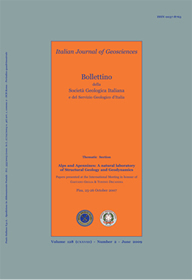
Exhumation in a fossil subduction channel: an example from the Ligurian Alps
L. Federico(**), L. Crispini(*), M. Scambelluri(*) & G. Capponi(*)
(**) Dip.Te.Ris. (Dipartimento per lo Studio del Territorio e delle sue Risorse), Università di Genova, C.so Europa, 26 - 16132 Genova, Italy.
(*) Corresponding author: Laura Federico Dip.Te.Ris., Università di Genova, C.so Europa, 26 - 16132 Genova, Italy. Phone +390103538292; fax +39010352169: e-mail: federico@dipteris.unige.it.
Volume: 128 (2009) f.2
Pages: 455-465
Abstract
Recent models propose that the exhumation of high-pressure rocks occurs by means of a return flow inside a subduction channel of low viscosity serpentinite between the confronting plates. Model predictions include different pressure-temperature paths and ages in the exhumed subduction complexes.
We studied a serpentinitic mélange in the Ligurian Alps to test this hypothesis. It contains exotic tectonic blocks with respect to the surrounding metaophiolites, which equilibrated at different peak metamorphic conditions and record different segments of a typical subduction P-T path. Both structural evidence and P-T paths of the different blocks suggest coupling between blocks and matrix in the blueschist facies.
We obtained 39Ar/40Ar ages for the eclogite facies peak (43.2±0.5 Ma) and for the blueschist facies peak (39.95±0.37 Ma and at 43.4±0.5 Ma) in different blocks; these data point to diachronous metamorphic trajectories and independent tectonic evolution of the different slices inside the channel. Inasmuch as the geochronological, petrographic and structural data fit the predictions of numerical models in terms of different pressure-temperature paths and variable metamorphic ages, we suggest that the studied mélange has been originated in the subduction channel. This mechanism can be extended to other serpentinitic mélanges in the Alps and other orogens, for which we expect further investigations will show a growing heterogeneity in the timing of metamorphic equilibration and of P-T paths.
Keywords
Get Full Text